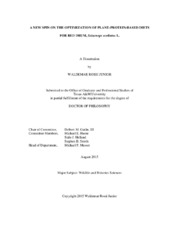| dc.contributor.advisor | Gatlin, III, Delbert M | |
| dc.creator | Rossi Junior, Waldemar | |
| dc.date.accessioned | 2015-10-29T19:51:14Z | |
| dc.date.available | 2017-08-01T05:37:39Z | |
| dc.date.created | 2015-08 | |
| dc.date.issued | 2015-07-17 | |
| dc.date.submitted | August 2015 | |
| dc.identifier.uri | https://hdl.handle.net/1969.1/155595 | |
| dc.description.abstract | Red drum, Sciaenops ocellatus, is a highly prized marine teleost whose supply largely depends on aquaculture. Commercial diets for red drum still contain considerable amounts of fishmeal (FM), which has become a scarce and increasingly costly protein source. Therefore, the evaluation of alternative-protein feedstuffs and the optimization of low-FM and growth-promoting aquafeeds can add sustainability to red drum aquaculture.
Five feeding trials were conducted to assess the nutritional value of a range of plant-protein (PP) feedstuffs as partial substitutes for dietary FM in early-stage juvenile red drum. Results from Trial I indicated that soy protein concentrate (SPC) and barley protein concentrate can replace 50% of dietary FM protein without compromising the production performance of red drum. Test diets high in PP reduced the growth performance of red drum in Trial II, but a set of promising PP feedstuffs was screened. The digestibility of a commodity and an enzymatically treated soybean meal (ESBM) was assessed in Trial III. Results from Trials IV and V revealed that ESBM can replace up to 70% of FM digestible protein (DP) in the diet of red drum.
Two soy products (SP) were evaluated as partial substitutes for FM DP in the diet of advanced juvenile red drum in Trial VI. Results revealed that 86% of FM DP can be substituted with a combination of SPC and either SP, while the supplementation of a yeast-based prebiotic (GroBiotic®-A; GBA) in a SP-based diet did not improve fish performance.
In Trials VII and VIII, effects of both diet type and GBA supplementation on the gut microbiota composition of red drum were observed. Denaturing gradient gel electrophoresis of PCR-amplified 16S rDNA and principal component analyses of MiSeq-sequenced genome indicated differences and similarities in microbiota diversity. An overwhelming dominance of the phylum Proteobacteria or Cyanobacteria was observed in distinct treatments.
The present research indicates that the aquafeed industry may utilized PP feedstuffs to replace dietary FM protein from 50 to 86% without compromising production performance of early-stage as well as advanced juvenile red drum. Further research is recommended to elucidate the role of prebiotics in the nutrition of red drum. | en |
| dc.format.mimetype | application/pdf | |
| dc.language.iso | en | |
| dc.subject | Aquaculture | en |
| dc.subject | Aquafeed | en |
| dc.subject | Fishmeal | en |
| dc.subject | Plant | en |
| dc.subject | Protein | en |
| dc.subject | Red drum | en |
| dc.subject | Sciaenops ocellatus | en |
| dc.subject | Carnivorous | en |
| dc.title | A New Spin on the Optimization of Plant-Protein-Based Diets for Red Drum, Sciaenops ocellatus L. | en |
| dc.type | Thesis | en |
| thesis.degree.department | Wildlife and Fisheries Sciences | en |
| thesis.degree.discipline | Wildlife and Fisheries Sciences | en |
| thesis.degree.grantor | Texas A & M University | en |
| thesis.degree.name | Doctor of Philosophy | en |
| thesis.degree.level | Doctoral | en |
| dc.contributor.committeeMember | Hume, Michael E | |
| dc.contributor.committeeMember | Helland, Ståle J | |
| dc.contributor.committeeMember | Smith, Stephen B | |
| dc.type.material | text | en |
| dc.date.updated | 2015-10-29T19:51:14Z | |
| local.embargo.terms | 2017-08-01 | |
| local.etdauthor.orcid | 0000-0001-5609-6839 | |


